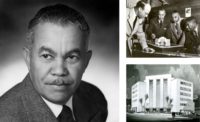The Boundary-Breaking Career of 2017 AIA Gold Medal Winner Paul Revere Williams

Paul Revere Williams worked in a variety of styles, from Spanish Colonial revival to Googie for LAX’s 1961 Theme Building, designed with William Pereira (shown here).
Photo © J. Paul Getty Trust, Getty Research Institute, Los Angeles
Paul Revere Williams (1894–1980) was a man both embraced and dismissed by the field in which he practiced. Though the architect, who was black, amassed a wide range of enviable commissions—from glamorous homes in the Hollywood Hills to large commercial and institutional projects—he struggled to be acknowledged as an equal: white clients routinely refused to shake his hand. After he redesigned the Beverly Hills Hotel, he was denied entry to the pool. He even learned to draw upside down, so that white patrons wouldn’t feel uncomfortable sitting at his side.
“I came to realize that I was being condemned, not by lack of ability, but by my color,” Williams wrote in a 1937 essay. “I wanted to vindicate every ability I had. I wanted to acquire new abilities. I wanted to prove that I, as an individual, deserved a place in the world.”
Over his five-decade career, the architect designed more than 3,000 buildings and became the American Institute of Architects’ first African-American member, as well as the first black person to be inducted into its college of fellows. Now the AIA has named Williams the recipient of its 2017 Gold Medal— the first black architect to be so honored.
“When I learned about Paul Revere Williams as a student, the message to me was, ‘I can do anything,’ ” says Phil Freelon of Perkins + Will, who presented Williams’s work to the awards jury. “It gives you hope. And that’s what this award is about.”
Williams’s life story unfolded like a movie in which his Hollywood clients acted. Born in Los Angeles in 1894 and orphaned at the age of 4, he was raised by a family friend. The only black child in his elementary school, he was discouraged from pursuing architecture because, his teachers told him, white clients wouldn’t want to work with him.
Undeterred, Williams became a licensed architect in 1921 and established his office at the age of 28. Southern California real estate was booming, and the firm thrived, building hundreds of opulent residences in styles ranging from Tudor Revival to Regency, French Chateau, and Mediterranean. Williams’s designs became so popular that Frank Sinatra, Barbara Stanwyck, and Lucille Ball and Desi Arnaz commissioned him for their houses. He also designed the Beverly Hills Saks Fifth Avenue, the Palm Springs Tennis Club, and a renovation of the star-studded Beverly Hills Hotel.
But Williams was also an architect for the less privileged. In the late 1930s, he collaborated with fellow African-American architect Hilyard Robinson on Langston Terrace, the nation’s first federally funded public housing project. In 1962, he designed the St. Jude’s Children’s Research Hospital pro bono for comedian Danny Thomas, the hospital’s patron.
“To him, the end result was the most important thing,” says Williams’s granddaughter and biographer, Karen Elyse Hudson. “He thought those buildings would stand as a testament to excellence and be an inspiration to other people.”
The award comes at a time when the AIA has been under intense scrutiny for its lack of diversity (the late Julia Morgan became the first woman architect to receive the Gold Medal in 2014). Less than 2 percent of AIA members are African-American, according to the organization’s most recent diversity survey.
When asked why the jury didn’t select a living African-American architect, Gold Medal jury chair Stephen Maher says, “I had a similar discussion. But when you learn about Williams’s work and what he was able to achieve, he was too special to pass on.”
The road to the AIA Gold Medal is a complicated process. This year, a pool of 16 contenders was submitted to the jury, who then whittled the list down to three finalists. (RECORD has learned that the other two were British architects Richard Rogers and the late Zaha Hadid.) The AIA’s board of directors and strategic council select the winner.
“It was long overdue,” says advocate Julia Donoho, AIA, of Williams’s win. She helped spearhead his nomination with Freelon, along with architects William J. Bates, William J. Stanley, and Kevin Holland, the president of the National Organization of Minority Architects.
But the work is not over, says Freelon. “The AIA can’t stop and say we’re done, we gave a black guy a medal, so we can check off diversity for 2017. That’s not enough. Nor is that the reason for this recognition—he deserves it regardless,” says Freelon. “But I want to keep this on a positive note, and I commend the AIA for their choice."


